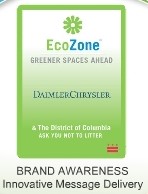Is there hope for a "Challenge Bibendum" equivalent for the DC government?
 EcoMedia: Selling the Environment?
EcoMedia: Selling the Environment?Probably not, judging by two articles in the Tuesday Washington Times, which communicate how difficult intelligent policy making appears to be in the City of Washington, a focus on glitz instead of substance, or a failure to lead in the face of pretty serious issues.
It frustrates me some that the DC Government announced to great fanfare an advertising program allowing street signs with "pro-environment" messages combined with advertising to be posted on major thoroughfares in the city, by creating an "EcoZone." For more, see the article "Ecological signs of the times."
The cost to the advertisers will be $5,000/sign; half of the money will be directed to pro-environment activities by EcoMedia, the company that somehow managed to snag this contract. Figure out the amount and the impact for yourself.
One of the signs pictured in the article is sponsored by Alcoa (which makes aluminum cans) and it states "Alcoa and the District of Columbia ask you not to litter." (The sign on the website, with a different caption from the article, highlights a different company, DaimlerChrysler.)

Rather than put up a sign like this, how about focused programs as I have discussed before, to build environmental stewardship and understanding into the schools, i.e., students being responsible for cleaning schools (as in Japan) and school-community cleanups in the fall and spring around each public school in the city?
 Photo of the sidewalk in front of 721-727 H Street NE by Elise Bernard.
Photo of the sidewalk in front of 721-727 H Street NE by Elise Bernard.And speaking of alumninum cans and recycling, how about a container deposit law, like the one that was fought off, partly with race-based appeals, by the beverage industry in 1988?
Or restrictions on the sales of single containers of beer, which seem to be "disposed of" disproprotionately in the public spaces? Etc.
____
This reminds me a bit of how the Children's Museum was supportive of BP's plans to build a 50,000 s.f. gas station across the street because it was a pro-environment project--because they were to use solar panels to provide electricity to the lights on the pump islands!!!??? (Plus, I'm sure there was a promise of a donation...)
____
The second Times article, "Parking permit fee increase cut by council," continues these theme of misplaced, underthought effort. The article states:
D.C. Council members yesterday said a proposal that would have increased fees for residential parking permits has been killed, citing press scrutiny. "I'd say 99.9 percent of it is because of the coverage," said council member Jim Graham, Ward 1 Democrat. "I'm stopping short of saying 100 [percent]. It takes that type of press coverage to really call attention to something. It certainly did for me." ...
The proposal -- which was offered by D.C. Mayor Anthony A. Williams, a Democrat who is not seeking re-election -- would have increased residential parking permit fees from a flat $15 to $25 for a first, $50 for a second and $100 a third permit. It also would have limited households to no more than three parking permits.
The Washington Times, which normally promotes a pay-as-you-go no subsidy agenda--unless it is sprawl promoting--seems to be unconcerned about the cheap provision of city-owned land, a public asset, for parking.
Furthermore, given the scarcity of parking, discouraging multiple car households is sound public policy. Making people pay for the costs they impose on others, by increasing the price for parking permits is the way to go.
In rowhouse neighborhoods, the average house is 15-18 feet wide, which means that the street in front of the house can accommodate at best 1.25 cars. The more cars per household the more stress on the system. The more that parking is subsidized, the fewer cues (other than the difficulty of finding a parking space) to change behavior.
I find actions like these to be very frustrating. Makes me reconsider my campaign donation planning...

Index Keywords: environment; parking



0 Comments:
Post a Comment
<< Home